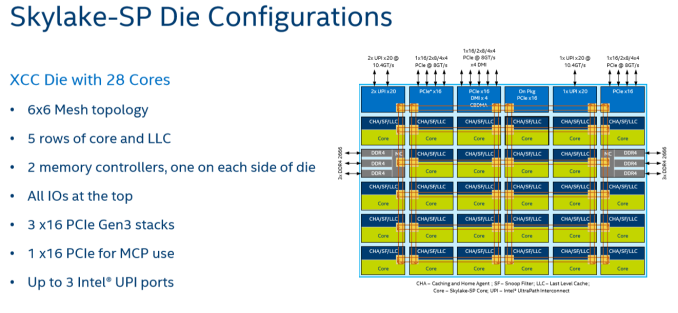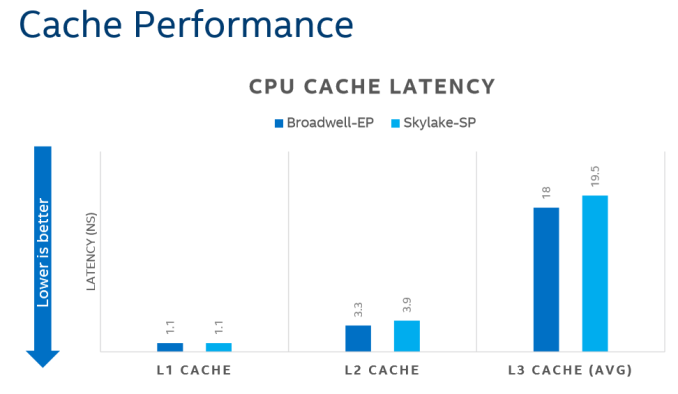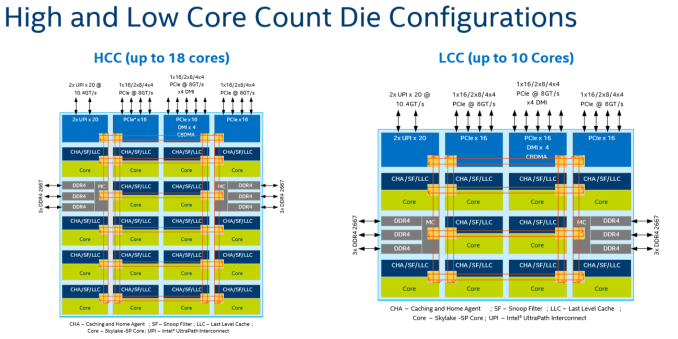Sizing Up Servers: Intel's Skylake-SP Xeon versus AMD's EPYC 7000 - The Server CPU Battle of the Decade?
by Johan De Gelas & Ian Cutress on July 11, 2017 12:15 PM EST- Posted in
- CPUs
- AMD
- Intel
- Xeon
- Enterprise
- Skylake
- Zen
- Naples
- Skylake-SP
- EPYC
Intel's New On-Chip Topology: A Mesh
Since the introduction of the "Nehalem" CPU architecture – and the Xeon 5500 that started almost a decade-long reign for Intel in the datacenter – Intel's engineers have relied upon a low latency, high bandwidth ring to connect their cores with their caches, memory controllers, and I/O controllers.
Intel's most recent adjustment to their ring topology came with the Ivy Bridge-EP (Xeon E5 2600 v2) family of CPUs. The top models were the first with three columns of cores connected by a dual ring bus, which utilized both outer and inner rings. The rings moved data in opposite directions (clockwise/counter-clockwise) in order to minimize latency by allowing data to take the shortest path to the destination. As data is brought onto the ring infrastructure, it must be scheduled so that it does not collide with previous data.
The ring topology had a lot of advantages. It ran very fast, up to 3 GHz. As result, the L3-cache latency was pretty low: if the core is lucky enough to find the data in its own cache slice, only one extra cycle is needed (on top of the normal L1-L2-L3 latency). Getting a cacheline of another slice can cost up to 12 cycles, with an average cost of 6 cycles.
However the ring model started show its limits on the high core count versions of the Xeon E5 v3, which had no less than four columns of cores and LLC slices, making scheduling very complicated: Intel had to segregate the dual ring buses and integrate buffered switches. Keeping cache coherency performant also became more and more complex: some applications gained quite a bit of performance by choosing the right snoop filter mode (or alternatively, lost a lot of performance if they didn't pick the right mode). For example, our OpenFOAM benchmark performance improved by almost 20% by choosing "Home Snoop" mode, while many easy to scale, compute-intensive applications preferred "Cluster On Die" snooping mode.
In other words, placing 22 (E7:24) cores, several PCIe controllers, and several memory controllers was close to the limit what a dual ring could support. In order to support an even larger number of cores than the Xeon v4 family, Intel would have to add a third ring, and ultimately connecting 3 rings with 6 columns of cores each would be overly complex.
Given that, it shouldn't come as a surprise that Intel's engineers decided to use a different topology for Skylake-SP to connect up to 28 cores with the "uncore." Intel's new solution? A mesh architecture.
Under Intel's new topology, each node – a caching/home agent, a core, and a chunk of LLC – is interconnected via a mesh. Conceptually it is very similar to the mesh found on Xeon Phi, but not quite the same. In the long-run the mesh is far more scalable than Intel's previous ring topology, allowing Intel to connect many more nodes in the future.
How does it compare to the ring architecture? The Ring could run at up to 3 GHz, while the current mesh and L3-cache runs at at between 1.8GHZ and 2.4GHz. On top of that, the mesh inside the top Skylake-SP SKUs has to support more cores, which further increases the latency. Still, according to Intel the average latency to the L3-cache is only 10% higher, and the power usage is lower.
A core that access an L3-cache slice that is very close (like the ones vertically above each other) gets an additional latency of 1 cycle per hop. An access to a cache slice that is vertically 2 hops away needs 2 cycles, and one that is 2 hops away horizontally needs 3 cycles. A core from the bottom that needs to access a cache slice at the top needs only 4 cycles. Horizontally, you get a latency of 9 cycles at the most. So despite the fact that this Mesh connects 6 extra cores verse Broadwell-EP, it delivers an average latency in the same ballpark (even slightly better) as the former's dual ring architecture with 22 cores (6 cycles average).
Meanwhile the worst case scenario – getting data from the right top node to the bottom left node – should demand around 13 cycles. And before you get too concerned with that number, keep in mind that it compares very favorably with any off die communication that has to happen between different dies in (AMD's) Multi Chip Module (MCM), with the Skylake-SP's latency being around one-tenth of EPYC's. It is crystal clear that there will be some situations where Intel's server chip scales better than AMD's solution.
There are other advantages that help Intel's mesh scale: for example, caching and home agents are now distributed, with each core getting one. This reduces snoop traffic and reduces snoop latency. Also, the number of snoop modes is reduced: no longer do you need to choose between home snoop or early snoop. A "cluster-on-die" mode is still supported: it is now called sub-NUMA Cluster or SNC. With SNC you can divide the huge Intel server chips into two NUMA domains to lower the latency of the LLC (but potentially reduce the hitrate) and limit the snoop broadcasts to one SNC domain.














219 Comments
View All Comments
ddriver - Tuesday, July 11, 2017 - link
Gotta love the "you don't care about the xeon prices" part thou. Now that intel don't have a performance advantage, and their product value at the high end is half that of amd, AT plays the "intel is the better brand" card. So expected...OZRN - Wednesday, July 12, 2017 - link
You need some perspective. Database licensing for Oracle happens per core, where Intel's performance is frequently better in a straight line and since they achieve it on lower core count it's actually better value for the use case. Higher per-CPU cost is not so much of a concern when you pay twice as much for a processor license to cover those cores.I'm an AMD fan and I made this account just for you, sweetheart, but don't blind yourself to the truth just because Intel has a history of shady business. In most regards this is a balanced review, and where it isn't, they tell you why it might not be. Chill out.
ddriver - Thursday, July 13, 2017 - link
You are such a clown. Nobody, I repeat, NOBODY on this planet uses 64 core 128 thread 512 gigabytes of ram servers to run a few MB worth of database. You telling me to get pespective thus can mean only two things, that you are a buthurt intel fanboy troll or that you are in serious need of head examination. Or maybe even both. At any rate, that perfectly explains your ridiculously low standards for "balanced review".Notmyusualid - Friday, July 14, 2017 - link
It seems no matter what opinion someone presents that might exhibit Intel in a better light - you are going to hate it anyway.What a life you must lead.
OZRN - Friday, July 14, 2017 - link
No, they don't. They use them to host gigabytes to terabytes worth of mission critical databases, with specified amounts of cores dedicated to seperate environments of hard partitioned data manipulation. I've done some quick math for you and in an average setup of Enterprise Edition of Oracle DB, with only the usually reported options and extras, this type of database would cost over $3.7m to run on *64 cores alone*. At this point, where is your hardware sunk costs argument?Also, I don't think anyone here is impressed by your ability to immediately personally insult people making valid points. Good luck finding your head that deep in your colon.
CajunArson - Tuesday, July 11, 2017 - link
"All of our testing was conducted on Ubuntu Server "Xenial" 16.04.2 LTS (Linux kernel 4.4.0 64 bit). The compiler that ships with this distribution is GCC 5.4.0."I'd recommend using a more updated distro and especially a more up to date compiler (GCC 5.4 is only a bug-fix release of a compiler from *2015*) if you want to see what these parts are truly capable of.
Phoronix does heavy-duty Linux reviews and got some major performance boosts on the i9 7900X simply by using up to date distros: http://www.phoronix.com/scan.php?page=article&...
Considering that Purley is just an upscaled version of the i9 7900X, I wouldn't be surprised to see different results.
CajunArson - Tuesday, July 11, 2017 - link
As a followup to my earlier comment, that Phoronix story, for example, shows a speedup factor of almost 5X on the C-ray benchmark simply by using a modern distro with some tuning for the more modern Skylake architecture.I'm not saying Purley would have a 5X speedup on C-ray per-say, but I'd be shocked if it didn't get a good boost using modern software that's actually designed for the Skylake architecture.
CoachAub - Wednesday, July 12, 2017 - link
Keywords: "actually designed for the Skylake architecture". Will there be optimizations for AMD Epyc chips?mkozakewich - Friday, July 14, 2017 - link
If it's a reasonable optimization, it makes sense to include it in the benchmark. If I were building these systems, I'd want to see benchmarks that resembled as closely as possible my company's workflow. (Which may be for older software or newer software; neither are inherently more relevant, though benchmarks on newer software will usually be relevant further into the future.)CajunArson - Tuesday, July 11, 2017 - link
And another followup: The time kernel compilation on the i9 7900X got almost a factor of 2 speedup over the Ubuntu 16.04 using more modern distros.